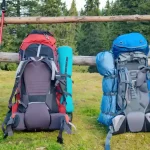

As nature lovers and outdoor enthusiasts, camping provides us with the opportunity to connect with the natural world and appreciate the beauty of wildlife. However, it is important to remember that we are visitors in their home, and it is our responsibility to protect and respect the wildlife and their habitats. In this blog post, we will explore ways to practice wildlife conservation while camping, and how we can appreciate nature in a responsible and sustainable manner.
Respect Wildlife and their Habitat
When camping in natural areas, it is crucial to respect the wildlife and their habitat. Here are some key practices to keep in mind:
- Observe wildlife from a distance: Do not approach, feed, or disturb wildlife. Keep a safe distance and use binoculars or a zoom lens for close-up observations. Remember that wildlife are wild animals and their behavior can be unpredictable. Respect their space and do not disrupt their natural behaviors.
- Store food and trash properly: Keep your campsite clean and free of food scraps or trash that may attract wildlife. Store food, trash, and scented items in wildlife-proof containers or bear-resistant canisters, if required by the area’s regulations. Proper food and trash storage helps prevent wildlife from becoming habituated to human food, which can lead to dangerous interactions between wildlife and humans.
- Follow designated trails: Stick to designated trails and avoid trampling on vegetation or disturbing wildlife habitats. By staying on established trails, you can help protect fragile ecosystems and minimize your impact on wildlife habitats.
- Avoid disturbing nesting or denning sites: Be aware of nesting or denning sites of wildlife, such as bird nests, burrows, or dens, and avoid disturbing them. Disturbing nesting or denning sites can disrupt wildlife behavior and cause unnecessary stress or harm.
- Do not feed wildlife: Feeding wildlife can disrupt their natural behaviors and cause dependence on human food. It can also lead to habituation, where wildlife lose their fear of humans and may become aggressive in their search for food. Never feed wildlife, even if they appear to be hungry or friendly.
Practice Responsible Wildlife Photography
Wildlife photography can be a rewarding experience, but it is important to practice responsible and ethical photography to ensure the well-being of wildlife. Here are some tips for responsible wildlife photography:
- Use a long lens: Use a long lens to capture close-up photos of wildlife without disturbing them. Avoid approaching wildlife too closely or using flash, as it can startle or stress wildlife.
- Respect restricted areas: Follow any designated wildlife photography guidelines or restricted areas to protect wildlife habitats or sensitive areas. Do not trespass or disturb restricted areas, even for the sake of capturing a great photo.
- Do not bait or lure wildlife: Do not use food or other bait to lure wildlife for photography purposes. It can disrupt their natural behaviors and cause dependence on human food.
- Be patient and observe from a distance: Spend time observing wildlife from a safe distance and be patient to capture natural behaviors without disturbing them. Do not force wildlife to change their behavior or move for a better shot.
- Share photos responsibly: When sharing wildlife photos, be mindful of the impact it may have on wildlife and their habitats. Avoid geotagging or disclosing specific locations of vulnerable or endangered species to protect them from potential harm or disturbance.
Leave No Trace and Leave Wildlife Undisturbed
Practicing Leave No Trace principles is not only important for minimizing your impact on the environment, but also for protecting wildlife and their habitats. Here are some Leave No Trace principles to keep in mind:
- Pack out all trash: Always pack out your trash and litter, including food scraps and leftover bait. Dispose of it properly in designated receptacles or pack it out in sealed bags to avoid attracting wildlife to your campsite.
- Minimize campfire impact: Follow local regulations and guidelines for campfires, and always use established fire rings or fire pans. Do not burn food scraps or trash, as it can attract wildlife to your campsite.
- Respect quiet hours: Respect designated quiet hours to minimize noise pollution that may disturb wildlife and disrupt their natural behaviors.
- Use established campsites: Set up your campsite in established areas to minimize your impact on wildlife habitats. Avoid trampling on vegetation or disturbing wildlife habitats when choosing a campsite.
- Use biodegradable or reusable camping products: Choose biodegradable or reusable camping products to minimize your waste and reduce your impact on the environment. Avoid single-use plastics and dispose of any waste properly.
- Be mindful of your pets: If camping with pets, always keep them on a leash and under control. Do not allow them to chase or disturb wildlife, and always clean up after them to prevent any negative interactions with wildlife.
- Educate yourself about local wildlife: Research and learn about the local wildlife and their behaviors before your camping trip. This knowledge will help you understand how to properly interact with wildlife and appreciate them from a distance.
In conclusion, wildlife conservation is an essential aspect of responsible camping. By respecting wildlife and their habitats, practicing responsible wildlife photography, following Leave No Trace principles, and being mindful of our actions, we can protect and appreciate nature while camping. Let’s strive to leave wildlife undisturbed and ensure that future generations can also enjoy the beauty of wildlife in their natural habitats.
For more information on sustainable camping practices read our post here
For more camping tips go here
Author

Sarah Patel
Sarah is a travel writer and photographer, with a passion for exploring new destinations and cultures. She's traveled extensively throughout the world and has written for several major travel publications. Sarah is also an avid camper and outdoor enthusiast, and loves to combine her love of travel with her love of the outdoors. She's always on the lookout for unique and off-the-beaten-path campsites
Recent Posts


